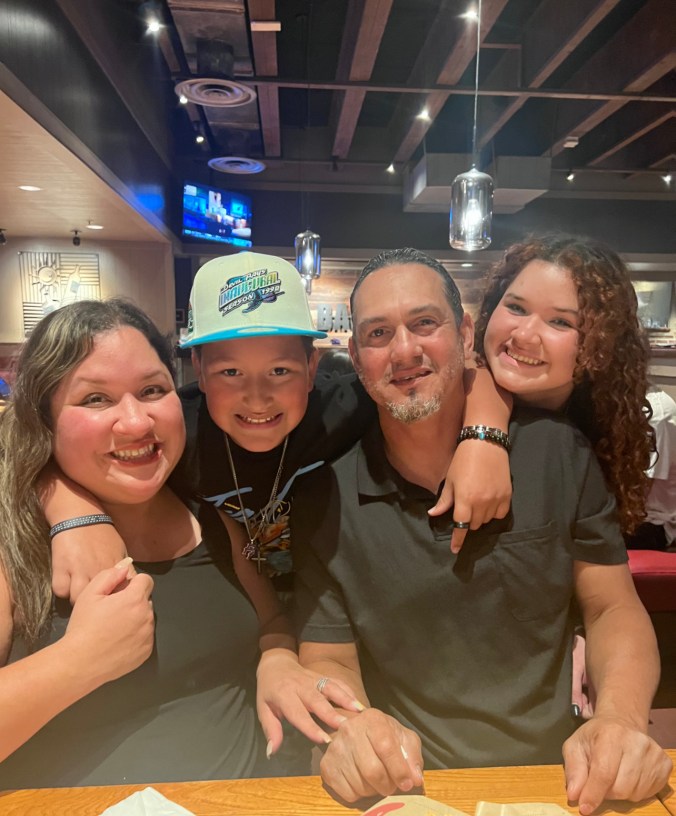Hi! My name is Amanda, and I am Mentor of the Month for October. It is fitting that I get October since “Spooky Season” is my family’s favorite time of year!
My husband Christopher, our son Jacob, and I live with our two cats and three dogs in my hometown in beautiful NW Montana.

We are a neurodivergent and chronic illness family. Christopher has ADHD & Cystic Fibrosis. Jacob, who will be 14 this Winter, has ADHD and Dysgraphia. I have ADHD, Dyscalculia & an autoimmune disease that leaves me with chronic pain and fatigue.
Before we adopted Jacob, I had thought I would prefer to Unschool but my husband wasn’t 100% on board. Especially since he (and I to a certain extent) are products of the public school system. Then, when Jacob was school age, Christopher’s health took a sharp decline and the decision was made for us. We spent months on end living in the hospital (often in cities hundreds of miles away from our home) and I became my husband’s full time caregiver basically overnight. Unschooling fit our needs perfectly at the time and “schooling” happened naturally through life and play just as it had when Jacob was little. Leaving me able to focus on both of my guy’s needs.
But when Jacob was about 8 years old, Christopher started the process of being listed for a double lung transplant and was dealing with a hole in his heart and uncontrolled Cystic Fibrosis Related Diabetes, leaving him hospitalized more than he was home. That’s when we noticed that the constant uncertainty that comes along with a dying parent and never knowing where you might be from one day to the next had taken its toll on Jacob’s mental health. It quickly became evident that he needed some structure, routine, and normalcy somewhere in his life. The only solution I could come up with was that we needed to add a curriculum.
The problem was that I don’t believe in boxed curriculum. I had already seen with Jacob what I knew in my heart to be true since I was a child myself, and that is that we devour and retain what we are interested in. And that’s when a simple Google search, “is there an Unschooling curriculum”, led me to Fun-Schooling!
Our transition wasn’t as smooth as I wish it had been. We started with one Core Journal, Monkey Doodle because it was on sale on Amazon. Jacob could read well above grade level but writing was a huge struggle. I was overwhelmed with my husband’s failing health and while Jacob desired to be able to use the journal we purchased, I just couldn’t figure out how to make it work if he couldn’t write and didn’t like to draw or color. Thankfully, the mothers and Mentors in the Fun-Schooling with The Thinking Tree Facebook group came to the rescue and recommended having him tested for Dysgraphia and suggested I scribe for him and utilize technology such as speak-to-text to get him started, they also suggested using stickers, magazines and pictures for the art pages. And most importantly they suggested we add Dyslexia Games.
We took all of their suggestions to heart and it made all the difference. That first journal saved Jacob in the beginning when we were all on the verge of breaking and now we can’t imagine any other way except Fun-Schooling. Dyslexia Games gave him the ability to write. He is never going to hand write a book and will likely never have beautiful handwriting, but he can hand write a handful of paragraphs at one time when he needs to. He uses the Internet, podcasts, videos, audiobooks, and digital books as resources more than physical ones because we always have a mobile device with us. And the journals guide him and give him structure while still letting him be a Delight Directed Learner, and somewhere along the way he started enjoying drawing and coloring some too.

In November of 2019, Christopher received the life changing drug, Trikafta, and our lives completely changed again. He has almost 50% lung function (which is amazing since he was down to 20% before) and we haven’t spent even one night in the hospital since. He still gets depressed that he is unable to work, and has to be extra careful around people and germs, but he is so so grateful to be alive! Jacob is thriving thanks to Fun-Schooling and therapy. And I’m happy because I’m back to being a wife and provider for my family.
Jacob is old enough to work mostly independently now. He gets most of his “book work” done while I’m at work. In the evenings that he doesn’t have an extracurricular activity happening we look over his discoveries together, or we turn on a podcast and do chores or pull out our favorite journals and take notes. At night when I’m winding down or on my days off I take the time to do some Mom-School. I’m currently working on Brain Games: Morning Light, Animal Lovers Journal, & the All About Dogs Journal. And of course I purposefully practice self care and have a creative outlet. Because the one thing I have learned above all others over these past few years is that everyone suffers when I drain my cup completely dry.
My favorite part, our favorite part, of Fun-Schooling we have been able to utilize it to fit our families needs every step along the way! From the scariest moments of our lives to the thriving ones Fun-Schooling has been there.












































